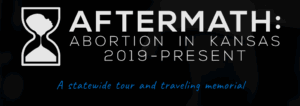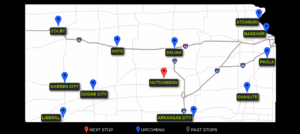While surrounding states have worked to reduce the number of abortions since the overturn of Roe v. Wade, they’ve nearly tripled in Kansas since the state’s Supreme Court conceived of a right to the procedure in the state’s constitution.
Now a new and unprecedented walk-through exhibit from Kansans for Life will travel the state Sept. 13 to Oct. 25 to put residents face to face with the facts and impacts of that radical sea change.
The free outdoor exhibit “AFTERMATH: Abortion in Kansas 2019-Present,” of which The Heartlander was given an exclusive preview, will allow visitors to browse the staggering statistics, ponder the reasons for them, and feel the mournful impact of so many lives lost, as well as pledge to do something – anything – to turn back the tide of red.
How extreme has the state’s explosion in abortions been? In 2019 – the year the Kansas Supreme Court would go on to deduce a right to abortion in the state constitution – there were 6,916 abortions according to the state. That number has risen to a stunning 19,467 in 2023, the last year for which numbers are available.
That steep surge includes a breathtaking 58% increase from just the year prior.
The number of known abortion facilities in Kansas also has more than doubled, from three to at least seven.
The state, in short, has become a Midwest hub for the abortion industry.
The question is, have residents wrapped their arms around that?

Contemplating the inconceivable
And how can you wrap your arms around 19,467 dead? Perhaps by seeing it for yourself: Visitors to AFTERMATH will walk past tables displaying an otherwise inconceivable 19,467 models of aborted babies – all calibrated in size by their gestational ages.
It’s a kind of traveling memorial – not just to the lives lost, but to every life impacted by it.
It won’t be easy to see. But that’s the point: Kansans need to see what’s going on in their own back yard, Kansans for Life believes.
Nothing like this exhibit has ever been done before, figures Kansans for Life, which plans to replicate it next year. It likely will be copied, as well, by other pro-life organizations around the country.
The closest thing to it may have been last January’s KFL display at the annual March for Life in Topeka – for which the nonprofit borrowed another state’s baby models to raise awareness of the devastation.
Seeing how people cried and prayed over the babies there, KFL realized it needed to do more to explain the “why” of the eruption of abortions in the state.
The resulting AFTERMATH exhibit will be in the following cities for one-day visitations from 9 a.m. to 7 p.m.:
- Hutchinson: Holy Cross Catholic Church Sept. 13
- Hays: Outdoor Pavilion Sept. 22
- Colby: Fike Park Sept. 23
- Garden City: Stevens Park Sept. 24
- Liberal: Light Park, Sept. 25
- Dodge City: Wright Park, Sept. 26
- Atchison: Lewis & Clark Pavilion Sept. 27
- Salina: Jerry Ivey Memorial Park, Oct. 3
- Paola: Park Square Oct. 4
- Chanute: Santa Fe Park Oct. 10
- Basehor: Holy Angels Catholic Church Oct. 18
- Arkansas City: Rakie’s Oil Oct. 25

AFTERMATH’s allies and audiences
Churches in those communities are natural allies and audiences for the exhibit – but schools, homeschoolers and pro-life families may also want to expose their students and children to it. KFL says it’s most appropriate for Grade 5 and up.
Given the exhibit’s emphasis on science rather than sermon, local biology teachers and their students might also want to pay a visit.
“We want to engage the young people of Kansas in this fight,” says one pro-lifer.
While the news media generally aren’t all that accommodating to the pro-life message, KFL knows local media in the above locales can be instrumental in not only spreading the word about the exhibit, but also about the need for volunteers in each location.
AFTERMATHKS.com invites those volunteers to sign up – including men to tote heavy objects – as well as donors for what is an expensive traveling display. Visitors to the exhibit also can leave their poignant reflections for others on the website – or at the exhibit site itself.
The “why” of Kansas’ abortion explosion
The need for the exhibit would only seem to be growing: Since the state Supreme Court’s 2019 decision inferring a right to abortion in the constitution (Hodes & Nauser v. State of Kansas), abortion advocates have been successful in stripping Kansas of even basic regulations.
Indeed, twin decisions the court handed down in 2024 alone overturned a ban on dilation and evacuation (D&E) abortions and removed clinic regulations intended to provide for women’s and children’s safety.
Google AI, which is hardly considered a source of conservative views, describes D&E abortions as a procedure “used in the second trimester, typically up to 24 weeks” in which “the doctor uses forceps to grasp and tear the fetus’s limbs and body from the womb.
“Once the body is removed, the skull – the largest and hardest part – is crushed or compressed to allow for its extraction. A curette or suction device is then used to remove any remaining tissue, including the contents of the skull.”
That procedure is now legal in Kansas up to 22 weeks’ gestation.
In addition, the Kansas “Women’s Right to Know Act” is currently being challenged in court. It includes a 24-hour waiting period and requires:
- that “informed consent” information about risks be explained to the woman;
- disclosure of disciplinary actions against the abortionists employed by the clinic;
- and expanded state statistics to increase transparency
Hearings in that challenge are scheduled this month in a Johnson County court.
Abortion advocates also are seeking to water down Kansas requirements that actual doctors be involved in all abortions – particularly chemical, or pill, abortions, which now account for over 60% of abortions.
Study: pro-life laws save lives
Aiding abortion advocates in their efforts to eliminate abortion regulations in Kansas is voters’ failure to pass the “Value Them Both” constitutional amendment in 2022, which would’ve merely enshrined the authority of the Legislature to regulate the industry.
Out-of-state campaign contributions in that election by abortion advocates helped convince some Kansans the amendment would’ve sharply curtailed or ended abortion access, which wasn’t true.
Going forward, even the state’s prohibition on abortion after 22 weeks could theoretically be in danger.
In contrast, a new study in the Journal of the American Medical Association Network suggests abortion laws elsewhere in the country are saving lives: Researchers found states with abortion bans or restrictions saw over 22,000 more births than anticipated in 2023.
“If more babies are being born after pro-life laws take effect,” one pro-life expert observed of the study, “that is powerful statistical evidence that more unintended pregnancies are being carried to term – and lives are being saved – as a result of the pro-life law.”


